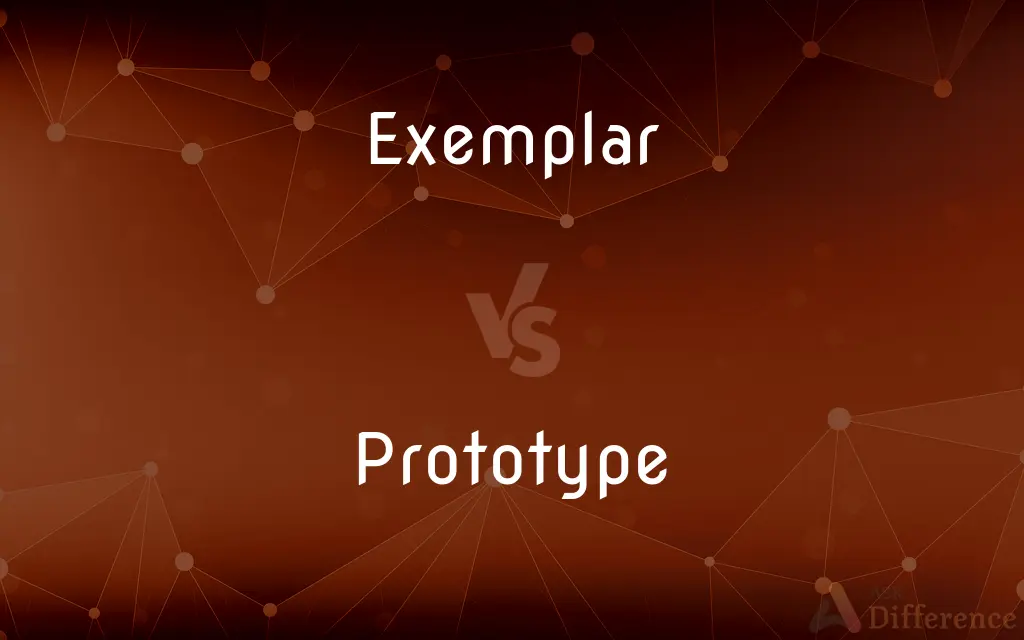Exemplar vs. Prototype — What's the Difference?
Edited by Tayyaba Rehman — By Fiza Rafique — Updated on April 4, 2024
An exemplar is a specific example that represents a larger category, whereas a prototype is an original model on which later versions are based.

Difference Between Exemplar and Prototype
Table of Contents
ADVERTISEMENT
Key Differences
Exemplars are detailed instances within a category that serve as a standard or typical example for comparison. They are often used in cognitive psychology to represent the concept of categorization, where each exemplar is a specific instance that people reference mentally when identifying or categorizing objects. On the other hand, prototypes are considered the quintessential representations of a category, not based on specific instances but on an abstract aggregation of the most common features observed in that category. Prototypes help in simplifying the categorization process by providing a mental image of what the average, most typical member of a category looks like.
While exemplars are about specific examples, prototypes are about general characteristics that represent a group. For instance, when thinking about the category of "birds," an exemplar approach would involve thinking about specific birds one has encountered, like a sparrow or a robin, and using those specific examples to inform one’s understanding of what a bird is. Conversely, the prototype approach might involve an abstract concept of a bird—such as a creature that flies, has feathers, and lays eggs—without relying on specific instances.
The use of exemplars is often more flexible because it allows for the inclusion of a wide variety of examples within a category, acknowledging the diversity within it. This method can be particularly useful in cases where categories are not clearly defined or have a lot of internal variation. Whereas, prototypes provide a more streamlined approach, making it easier and quicker to categorize new instances by comparing them to a single, idealized example.
In terms of learning and memory, exemplars provide a richer, more detailed base of knowledge because they are based on specific instances. This can lead to more nuanced understanding and better discrimination within categories. However, relying on exemplars can also make the categorization process more cognitively demanding, as it requires remembering and comparing multiple examples. Prototypes, by simplifying categories into single, idealized examples, reduce cognitive load and make it easier to quickly categorize new instances, though at the cost of nuance and specificity.
In practical application, the choice between using exemplars and prototypes can depend on the task at hand. In fields like artificial intelligence and machine learning, exemplar-based approaches (like instance-based learning) might be used for tasks requiring detailed, specific judgments, while prototype-based approaches might be more suited for tasks requiring quick, general categorization. This demonstrates how both concepts, despite their differences, play crucial roles in various cognitive processes and applications.
ADVERTISEMENT
Comparison Chart
Definition
A specific example representing a category.
An original model representing the average characteristics of a category.
Basis
Specific instances.
Generalized or idealized features.
Usage in Cognition
Used for detailed comparison and categorization.
Used for quick and general categorization.
Flexibility
High, allows for diverse examples.
Lower, focuses on common features.
Cognitive Load
Higher, requires remembering specific instances.
Lower, simplifies categorization process.
Compare with Definitions
Exemplar
A specific instance that serves as a representative example of a category.
A robin is an exemplar of the category birds.
Prototype
An original model that embodies the most typical features of a category.
A sparrow might serve as a prototype for the category birds due to its common characteristics.
Exemplar
Involves detailed memory and comparison of specific instances.
Recalling exemplars such as specific memorable meals can enhance one’s understanding of cuisine.
Prototype
Based on the abstraction of common features across many instances.
Prototypes for furniture might include features like legs, a flat surface, and the ability to support items.
Exemplar
Useful in situations requiring detailed understanding and discrimination.
In legal studies, exemplars of past cases are studied to understand precedents and nuances.
Prototype
Simplifies the categorization by focusing on general characteristics.
The prototype of a smartphone focuses on features like touchscreen, internet connectivity, and portability.
Exemplar
An example used to illustrate or explain a concept.
Using a golden retriever as an exemplar can help explain the concept of domestic dogs.
Prototype
A mental image that summarizes the average characteristics of a category.
The prototype of a car includes wheels, an engine, and seats, summarizing common features.
Exemplar
Based on multiple, specific instances within a category.
Exemplars like apples, oranges, and bananas help understand the fruit category.
Prototype
Ideal for quick generalization and categorization.
Prototypes are used in design to create new products that embody essential characteristics of a category.
Exemplar
One that is worthy of imitation; a perfect example or model.
Prototype
A prototype is an early sample, model, or release of a product built to test a concept or process. It is a term used in a variety of contexts, including semantics, design, electronics, and software programming.
Exemplar
One that is typical or representative; an example
An exemplar of poor research.
Prototype
An original type, form, or instance serving as a basis or standard
"The abolitionists were the prototype of modern citizen activism" (Adam Hochschild).
Exemplar
A copy, as of a book.
Prototype
An original, full-scale, and usually working model of a new product or new version of an existing product.
Exemplar
Something fit to be imitated; an ideal, a model.
Prototype
A typical example of a class or category
"He fit the prototype of the artist as social misfit and compulsive contrarian" (Stephen Holden).
Exemplar
A role model.
Prototype
To make a prototype of (a product).
Exemplar
Something typical or representative of a class; an example that typifies.
Prototype
An original form or object which is a basis for other forms or objects (particularly manufactured items), or for its generalizations and models.
Exemplar
A pattern after which others should be made; an archetype.
Prototype
An early sample or model built to test a concept or process.
The prototype had loose wires and rough edges, but it worked.
Exemplar
A well known usage of a scientific theory.
Prototype
(computing) A declaration of a function that specifies the name, return type, and parameters, but none of the body or actual code.
Exemplar
A handwritten manuscript used by a scribe to make a handwritten copy; the original copy of what gets multiply reproduced in a copy machine.
Prototype
(semantics) An instance of a category or a concept that combines its most representative attributes.
A robin is a prototype of a bird; a penguin is not.
Exemplar
A copy of a book or piece of writing.
Prototype
(motorsport) A type of race car, a racing sports car not based on a production car. A 4-wheeled cockpit-seating car built especially for racing on sports car circuits, that does not use the silhouette related to a consumer road car.
Exemplar
(obsolete) Exemplary.
Prototype
(transitive) To create a prototype of.
Exemplar
A model, original, or pattern, to be copied or imitated; a specimen; sometimes; an ideal model or type, as that which an artist conceives.
Such grand exemplar as make their own abilities the sole measure of what is fit or unfit.
Prototype
An original or model after which anything is copied; the pattern of anything to be engraved, or otherwise copied, cast, or the like; a primary form; exemplar; archetype.
They will turn their backs on it, like their great precursor and prototype.
Exemplar
A copy of a book or writing.
Prototype
A standard or typical example;
He is the prototype of good breeding
He provided America with an image of the good father
Exemplar
Exemplary.
The exemplar piety of the father of a family.
Exemplar
Something to be imitated;
An exemplar of success
A model of clarity
He is the very model of a modern major general
Common Curiosities
Can an object be both an exemplar and a prototype?
Yes, an object can serve as both an exemplar and a prototype, depending on the context and how it is used for categorization.
What is an exemplar?
An exemplar is a specific instance that represents a broader category, used for detailed comparison and understanding.
What is a prototype?
A prototype is an original model that represents the most common features of a category, used for general categorization.
In which fields are exemplars and prototypes particularly useful?
Exemplars and prototypes are useful in fields like psychology, artificial intelligence, design, and education for different purposes of categorization and learning.
What role do prototypes play in product design?
Prototypes serve as initial models that embody essential features of a product category, guiding the development of new products.
How do exemplars and prototypes differ in cognitive processing?
Exemplars require detailed memory and comparison of specific instances, whereas prototypes simplify categorization by focusing on general characteristics.
Why are exemplars important in learning?
Exemplars provide detailed knowledge and enhance understanding by allowing for the comparison of specific instances within a category.
How do exemplars affect cognitive load?
Exemplars increase cognitive load because they require remembering and comparing multiple specific instances.
Are prototypes always accurate representations of a category?
Not always; prototypes represent an idealized average that may not include all variations within a category.
How do prototypes simplify categorization?
Prototypes simplify categorization by providing a mental image of the most typical features of a category, making it easier to categorize new instances.
Can the concept of exemplars be applied to abstract ideas?
Yes, exemplars can represent specific instances of abstract ideas to facilitate understanding and discussion.
How can exemplars and prototypes complement each other in categorization?
Exemplars provide detailed, specific examples, while prototypes offer a general framework, together enriching understanding and categorization.
Share Your Discovery

Previous Comparison
Debond vs. Disbond
Next Comparison
Gift vs. MementoAuthor Spotlight
Written by
Fiza RafiqueFiza Rafique is a skilled content writer at AskDifference.com, where she meticulously refines and enhances written pieces. Drawing from her vast editorial expertise, Fiza ensures clarity, accuracy, and precision in every article. Passionate about language, she continually seeks to elevate the quality of content for readers worldwide.
Edited by
Tayyaba RehmanTayyaba Rehman is a distinguished writer, currently serving as a primary contributor to askdifference.com. As a researcher in semantics and etymology, Tayyaba's passion for the complexity of languages and their distinctions has found a perfect home on the platform. Tayyaba delves into the intricacies of language, distinguishing between commonly confused words and phrases, thereby providing clarity for readers worldwide.














































